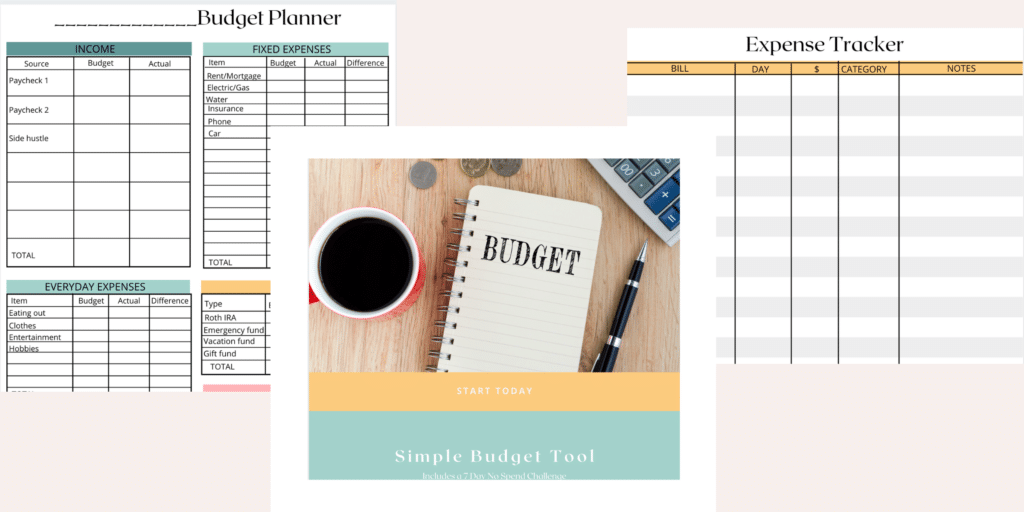3 Simple Budgets (Including a list of Pros and Cons)
Let’s face it – everyone needs a budget. Especially a simple budget.
New budgeters often hate the idea of having to budget. It can feel like pulling teeth (minus the dentist). It’s usually time-intensive and can be anxiety-provoking.
But there’s never going to be such a thing as having too much money.
Jeff Cooper from Have Your Dollars Make Sense wrote that “there is no amount of money that should be used without a purpose” in an article about 10 Frugal Things to Do with $10.
Regardless of how much money you have or are spending, you still need to have a budget. It’s the only way to tell your money where to go, rather than wonder where it went.
Budgeting holds you accountable to your financial situation and cements an investor mindset.
Well, I’m here to tell you there are 3 simple budgets for people who don’t necessarily like budgeting: the anti-budget budget, the 50-30-20 budget, and the zero-based budget.
In this article, we’re going to talk about these simple budgets and the pros and cons of each of them. Be sure to read to the end for a list of questions to ask yourself as you begin to budget and a free zero-based budget worksheet. But first, let’s start with the benefits of having a simple budget.
Table of Contents
Benefits to having a simple budget:
- Prevents overspending
- Gives you power over money
- Allows you to make plans for big purchases
- Reduces the stress of not having enough money
- Allows you to establish goals
- Helps you identify money problems before they occur
- Increases motivation to save, pay off debt, and give more
Types of simple budgets
Anti-Budget budget
This Anti-Budget budget is best for people who don’t like budgets and have a fixed set of bills. Determine how much you make, calculate all of your expenses for the month, determine how much you want to save/invest (pay yourself first), whatever is left is your spending money for the month. If you spend less than what you accounted for, you can put it in another savings account or invest it for the long term.
Pros: Simple. Quick. Doesn’t require you to track anything month after month. Allows you to be more flexible in planning your savings/investment budget.
Cons: Works best when your income and expenses are stable month-to-month.
50-30-20 budget
The 50-30-20 budget was coined by Senator Elizabeth Warren. It’s simple and intuitive. There are three simple steps to this budget: 50% of your after-tax income is spent on needs (anything you have to pay for), 30% on wants (because you have to have some fun in life), and 20% on savings and investing.
Pros: This budget sets realistic money goals based on personal income. It helps to prevent lifestyle inflation and being house poor. You don’t necessarily have to track each category and expense. You set aside a certain amount for each category, and that’s what you spend. It’s that simple.
Cons: Sometimes, when people start, they can only budget 5-10% for savings/investing. This may create some frustration for perfectionists. Remember, all that matters is that you have a plan to work towards your financial goals.
Zero-based budget
This budget was made famous by Dave Ramsey, and it is my favorite. While it may seem a little more complex than the other two, it’s simple once you get the hang of it. It offers the most accurate estimate of what is coming in and what is going out. This budget accounts for every dollar. It helps to prevent overspending.
I’ll admit there are times when I don’t want to look at my budget for fear that I am running low in one category or another. I want to avoid it and pretend that I have magical money sitting somewhere to do something extra. But it’s not reality, and the zero-based budget holds me the most accountable.
Pros: This budget holds budgeters the most accountable.
Cons: Very detailed oriented. Usually requires budgeters to be very meticulous. May require more time than the other two budgets. Can be frustrating for people when they don’t meet their goals.
Spend cash and use gift cards
Regardless of the budget you choose to use, be sure to take your money out of the checking account. Use cash. And if you don’t like cash, put the money on a gift card. This will prevent overspending tremendously. Give it a try.
Look for areas to cut expenses
Be sure to look for expenses that you don’t need or use. Check out TrueBill, the app that helps you find unwanted subscriptions that you are paying for. Cancelling unused services sets you up to have more money to put to work in other areas.
Consider looking into a cash-reward program. Most stores offer cash-back in the form of store rewards. But there are also apps to help you get cash back. Gone are the days of coupons. Now you login to an app like Rakuten and Ibotta, select the store your shopping and get 1-10% cash back sent to your PayPal account once a quarter or so.
Pro Tip: Don’t spend more than you have to.
Questions to ask yourself as you begin to budget:
- What are your financial goals?
- How much do you need to be investing every month to reach those goals?
- How much do you need to be saving every month for your big purchases?
- Can you do something to make some extra money? Check out this list of side hustles:
- Start a blog (my personal favorite)
- Become a Proofreader
- Help others with tutoring
- Teach a language online
- Fill out surveys
- Sell t-shirts online
- Become an event planner
- Become a freelance writer
- Write a book
- Become a social media expert
- Become a virtual assistant
- Become a social media manager (Facebook ads, Pinterest, Instagram)
- Design graphics
- Develop and teach an online course
- Edit videos
- Become a website designer
- Sell crafts or digital products on ETSY or Amazon
- What is your plan if you go over your budget?
- Are you going to take from the emergency fund?
- Are you going to make more money next month?
- Are you going to spend less money next month?
- Do you have a support circle?
- Do you have anyone that you can talk about money to?
- How are your friends and family going to react when your spending habits change?
- What can you do to help increase financial literacy for yourself and your inner circle?
- When are you going to check in with your budget and goals?
- Every day? Every week? Every month?
- Why?

Conclusion
Everyone can benefit from a budget to build wealth. The best budget is the one you are going to use.
It’s less about how much you make and more about how much you have left to invest. Be sure to check out my free zero-based budget worksheets to get you started. It’s as simple as writing down your income, expenses, debt, and savings/investments and making sure they’re balanced. I know you can do it. Comment below on your favorite types of budgets.
Theresa is a personal finance blogger. She writes content for busy professional women to take control of their money and investments. She enjoys reading, traveling, cooking, and writing. Her work has been featured on GoBanking Rates, Your Money Geek, Savoteur, the Corporate Quitter, Thirty Eight Investing, and more.
